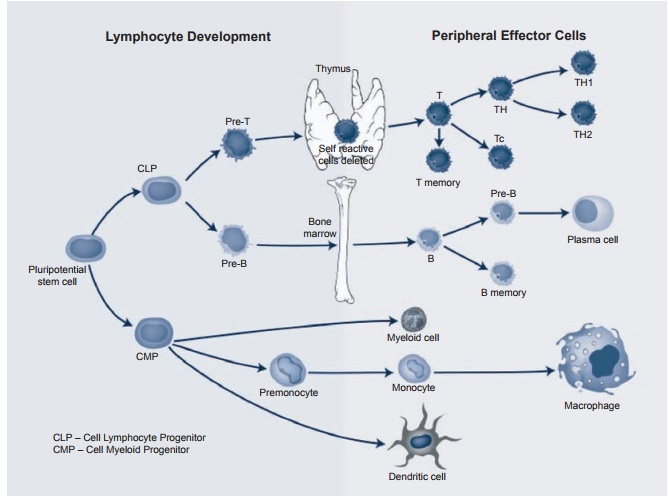Chapter: Essential Clinical Immunology: Basic Components of the Immune System
Basic Components of the Immune System
Basic Components of the Immune
System
INTRODUCTION
It is generally believed that the immune system
evolved as the host’s defense against infectious agents, and it is well known
that patients with deficiencies in the immune system generally succumb to these
infectious diseases. However, as we shall see, it may well play a larger role
in the elimina-tion of other foreign substances, including tumor antigens or
cells and antibodies that attack self.
An immune response may be conve-niently divided into
two parts: (1) a specific response to a given antigen and (2) a more
nonspecific augmentation to that response. An important feature of the specific
response is that there is a quicker response to the antigen during a second
exposure to that antigen. It is the memory of the initial response that
provides the booster effect.
For convenience, the specific immune response may
be divided into two parts:
(1) the humoral response and (2) the cellu-lar
response to a given antigen. As we shall see, however, both responses are
medi-ated through the lymphocyte. Humoral responses are antibodies produced in response
to a given antigen, and these anti-bodies are proteins, have similar
structures, and can be divided into various classes of immunoglobulins.
Cellular responses are established by cells and can only be trans-ferred by
cells. (See the Bibliography for the extraordinary beginnings of the con-cept
of a cellular arm of the immune sys-tem.) Up to the 1940s the general dogma
held that only antibodies were involved in the immune response. Dr. Merrill
Chase, who began his experiments in a labora-tory devoted primarily to the
humoral response, clearly showed in a series of ele-gant experiments that
immunity was not just humoral but that a cellular response by the lymphocytes
could also produce immunity. Some of the best examples of the power of cellular
immunity may be found in the many experiments in which transfer of cells can
induce autoimmune disease in animals and humans as well as rejection of an
organ graft in both animals and humans by cells.
The separation of human and cellular immunity was
further advanced by the study of immunodeficient humans and animals. For
example, thymectomized or congenitally athymic animals as well as humans cannot
carry out graft rejection, yet they are capable of producing some antibody
responses. The reverse is also true. Children (and animals) who have an immune
deficit in the humoral response do not make antibodies but can reject
grafts and appear to handle viral, fungal, and some
bacterial infections quite well. An extraordinary finding by Good and
colleagues in studying the cloacal lym-phoid organ in chickens revealed that,
with removal of the bursa Fabricius, these animals lost their ability to
produce anti-bodies and yet retained the ability to reject grafts.
Out of these and many other contribu-tions, a
clearer picture of the division of efforts by lymphocytes begins to emerge.
Since cellular immune responses require an intact thymus, cellular immune
responses are mediated through the T lymphocytes (thymus), while
antibody-producing cells, which are dependent on the bone mar-row (the bursa
equivalent), are known as B (bursa) cells. The pathways of both cell types are
depicted in Figure 1.1.

Figure 1.1 Development
and differentiation of lymphocytes from pluripotential stem cells.
Several types of molecules play a vital role in the
immune response, and we will deal with each in detail. Antigens, both foreign
and self, are substances that may or may not provoke an immune response. Both T
cells and B cells have receptors that recognize these antigens. In the case of
B cells, antibodies on the surface are a major source (but not the only one) of
antigen recognition, and once activated, they differen-tiate into plasma cells
that produce large quantities of antibodies that are secreted into blood and
body fluids to block the harmful effects of the antigen.
T cells have similar receptors known as T-cell
receptors (TCR), and in the con-text of the major histocompatibility complex
(MHC) molecules provide a means of self-recognition and T-lymphocyte effector
functions. Often these effector functions are carried out by messages
transmitted between these cells. These soluble messen-gers are called interleukins or cytokines.
Related Topics